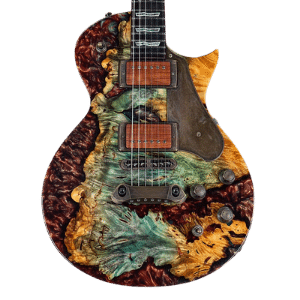
We all love a great-looking axe but are cool guitar finishes enough to justify the purchase? The guitar body’s finish is one of the first things we look at it can be a powerful determinant of our initial opinion of the instrument.
In this article, I’ll tell you what other things you should consider when buying an electric guitar.
If you’re thinking about making a purchase then please read this piece before you take the plunge!
Cool Guitar Finishes Rock!
You walk through your favorite music store or surf the net and there it is! It calls out to you and even seems to know your name! This absolute beauty is the one you’ve been searching for and you just gotta have it.
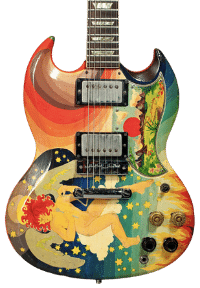
You picture yourself hammering out power chords and killing it with jaw-dropping solos! Your band members love it and the audience goes wild! The next thing you know, you’re reaching for your credit card to grab it before somebody else does.
Sound familiar? I can’t tell you how many cool-looking guitars I’ve wanted and even bought a few with little regard to anything else. Luckily I know how to adjust and modify guitars and that saved me on more than one occasion after a hasty purchase.

Way back in 1968, I saw Jimi Hendrix playing an olympic white Strat with a rosewood neck in a photo on the inside of his Electric LadyLand album. I just had to have one. It wasn’t long before I called the Fender factory and arranged to have it made and sent to my local music store.
I was just a freshman in high school and it took me almost two years to pay that guitar off. Fortunately, it played great and I still have it all these years later.
For more info on Jimi Hendrix, see Rock And Roll Hall Of Fame – The Killer Guitar Players!
Nobody wants to buy a guitar that doesn’t look great, but over the years I learned that there are several important things to consider, apart from the finish. Keep on reading to learn more.
What Else Is Important?
Here are some of the things that can affect the way a guitar plays and sounds. There are plenty of guitars that look great but won’t make you happy when you get them home.
If you’re buying a used guitar you need to be especially vigilant. Even a subtle problem might involve a costly repair but if you can’t do without the guitar you can use it to bargain the price down.
Neck
The size, shape, and fretboard radius of a guitar neck can make or break the way the instrument plays. Everyone’s hand is a little different so a neck that feels and plays well for me may not be what you like.
I’ve played some gorgeous-looking guitars that have some pretty uncomfortable necks.
If you are buying a used guitar did you carefully check out the neck? Severely wrapped necks may not be completely fixable with just a truss rod adjustment. Sometimes a cracked neck that was repaired may not be completely obvious and may eventually cause problems.
Nut
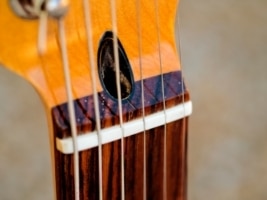
Critical Consideration
Is the nut a good fit for the kind of music you play? If you play jazz fusion then a locking nut for a whammy bar guitar is probably overkill and not a practical enhancement.
What is the nut made out of? Is it bone or a cheap plastic imitation? Nuts can also be self-lubricating (graphite).
This may sound trivial but you might be surprised how much a nut can affect the tone of a guitar!
Is the nut ok? I played one guitar that had toilet paper stuffed in a nut slot to keep the string from buzzing because someone filed it incorrectly!
Fingerboard Radius, Material, And Fret Type
The type of fingerboard and frets on a guitar are important determinants of how the neck feels and plays. If you’re used to playing a 7.5-inch radius fingerboard with vintage narrow frets then a 12-inch radius fingerboard with jumbo frets will be a very different playing experience.
The first type of neck may work better for a blues player, where the second type might be more suitable for metal players.
Always consider the fingerboard material, because each type can feel and play very differently. A maple fingerboard has a very smooth feel, especially when bending strings. Eric Clapton, another Rock And Roll Hall Of Fame inductee, prefers maple fingerboards on all his Stratocaster necks.
Rosewood has a much coarser grain, which gives a totally different feel. Ebony is typically “richer” looking than rosewood and has a tighter grain so it feels more like maple.
The fingerboard material can also change the tone of the guitar.
There is no real right and wrong, it’s just a matter of personal preference.
Body Shape, Wood, And Overcoat
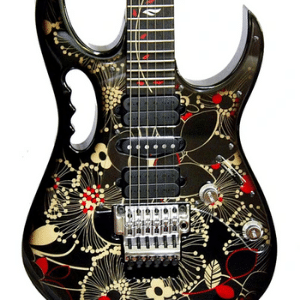
A guitar finish can be painted, stained, or natural wood-appearing with a Polyurethane (“Poly”), or Polyester overcoat, or it can be painted using a nitrocellulose lacquer (“Nitro”) finish.
A nitrocellulose guitar finish lets the wood “breath” and age better, while a finish with a Poly and polyester overcoat offers better scratch protection.
The guitar body is more than just something to show off an awesome finish. Various wood types (ash, alder, mahogany, etc.) can make a big difference in tone. I saw a great-looking guitar in a music store with a canary yellow body that, upon closer inspection, was made of multiple layers of plywood!
A heavier body can give you more sustain but may also be an important consideration if you have a back problem.
A rad body shape may look great but may not be comfortable to play. The body shape can also make access to the highest register notes easier or more difficult. For example, a Gibson SG guitar gives you total access to the highest part of the neck, see the photo of Eric Clapton’s guitar above.
You can always buy a guitar that sounds and plays exactly to your taste and then have the body refinished, or refinish it yourself.
I personally prefer fender guitar colors and PRS guitar finishes. There’s nothing like the look of a Fender custom color on a vintage guitar.
Here is a great video from Emerald City Guitars that talks about custom finishes on vintage Fender guitars. Have a look, they are awesome to behold but are pricy instruments!
Check out How To Relic Guitar Hardware – DIY With Awesome Results!
Pickups
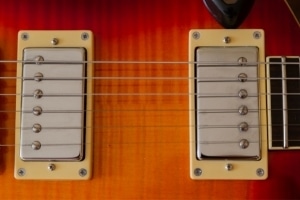
Pickups are the heart and soul of an electric guitar but they can behave unexpectedly. Pickups that sound great in one guitar might just sound ok in another. Cheap pickups very rarely sound good in any guitar.
Do you want single-coil or humbucking pickups? Single-coil pickups have a more focused, tighter sound. Single-coils pickups are prone to hum but noiseless single coils are also available. Pickups can be passive or active (connected to a battery-powered preamp inside the guitar).
Doing your homework to get more info about pickup brand and specs can pay off, but ultimately, the proof is in the playing.
Controls
Good pickups with cheap volume and tone controls or a bad pickup selector switch can be a problem. Cheap or worn-out volume and tone controls sound scratchy when you turn them.
You can usually tell a good switch by the way it makes a hardy “click” into place when you move it. If you hear noise in the amp as you change pickup configurations, this is not a good sign.
Hardware
Guitar hardware includes the tuning machines, string trees, neck plate, bridge (fixed or tremolo), and input jack. They can be made from a variety of materials. The most important hardware are the tuning machines, bridge, and input jack.
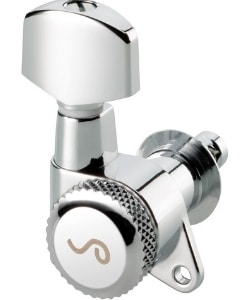
Tuning Machine
Who makes the tuning machines? What is the gear ratio? Are they “open” or “sealed? Are they locking tuners?
Is a tremolo bridge with a whammy bar necessary for the music you will play? Is it a brand name tremolo, like a Floyd-Rose? Does it have a high-quality tremolo block?
Bridge saddles can be critical to tone and sustain. What material are the bridge saddles made of? For more info, see Titanium Guitar Saddles – Make Your Guitar Sound Fantastic!
Don’t overlook the input jack. A cheap jack can give you a bad electrical connection to your amp. If you hear noise in the amp as you move around with the guitar then it’s probably the guitar jack, assuming your cable is ok.
High-quality input jacks usually make a nice “thump” when the guitar cable is plugged in and require a bit of a “tug” when unplugging it.
Storage And Transport
Most decent guitars come with something to store and transport them in. More expensive guitars should come with a sturdy hardshell case. Cheaper guitars may come with a “gig bag,” although a middle-priced guitar may come with a high-quality gig bag.
Always check out the guitar case or gig bag before buying the instrument. You can always ask the salesperson to give you a better one or get a deal on an upgrade. You don’t want to carry a good guitar in something that won’t protect it from damage, especially if you travel a lot.
Price
Generally, the more expensive the guitar, the more room there is to bargain. If you pay too much for a guitar that won’t have a good resale value then you could end up losing money if you want to trade it in to buy a better one down the road.
Always shop around for the best price. If you play a guitar in-store you can always buy it online to get a better price if the owner won’t come down.
Negotiate a free guitar setup into the final price, especially if you don’t know how to do it yourself.
If you already have a guitar, be patient and monitor the price online for things like holiday sales.
Checklist For Buying New Or Used Colorful Guitars
Here is a summary of the basic things to consider when buying a guitar.
| Category | Things To Consider |
|---|---|
| Neck | Neck Size, Shape, & Fretboard Radius, Neck Straight?, Nut Ok?, Fret Size Ok?, Fret Condition?, Maple, Rosewood, or Ebony Fingerboard? |
| Body | Finish, Wood Type (Alder, Ash, Mahogony), Weight, Fingerboard Access At Highest Frets |
| Pickups | Brand Name, Single-Coil vs Humbucker, Are single-Coils Noiseless? Passive vs Active |
| Controls | Volume and Tone Control Quality, Pickup Switch Quality |
| Hardware | Quality of Tuning Machines, Bridge, Tremolo, and Input Jack is Important |
| Transport | Study Hardshell Case? High-Quality Gig Bag? |
| Setup | Will Store Owner Do A free Guitar Setup At Time Of Purchase? |
| Warranty | Does Guitar Come With A Warranty, How Long, What Does It Cover? |
| Price | Shop In-Store and Online For Best Deal, Wait For A Holiday Sale? |
Final Thoughts On Cool Guitar Finishes

Who doesn’t like cool guitar finishes? Even if they don’t fit your style of playing they can be fun to look at and admire, especially an airbrush guitar finish. Most major guitar companies offer custom guitar finishes, especially on limited-edition models.
When buying a guitar, it’s important to consider some of the other characteristics and specifications that make it a useful tool to help you play your genre of music.
Always take a look at the guitar’s neck, body, pickups, controls, and hardware. If you just can’t live without a guitar because its finish totally dazzles you then can always make some easy modifications. Things like replacing the pickups with something that has the tone you want or swapping out a cheap pickup selector switch are practical considerations.
Buying a used guitar that needs a re-fret job may be more costly than the value of the instrument. You can always bargain down the cost of the guitar and use the money you saved to make the modifications.
If you buy a guitar that doesn’t suit your needs then you will probably end up selling it to get something more useful. With guitars, “try before you buy” is the best policy. Even if you play the guitar before you buy the identical model online, you might be surprised when you receive it.
No two guitars play and sound exactly the same, due to subtle variations in the manufacturing process, so make sure the online dealer accepts returns.
Tell Me What You Think

Please let me know what’s on your mind in the comment section, or if I can help you with anything.
- Have you ever bought a guitar with a custom body finish? Do you still have it?
- What is the coolest-looking guitar finish you have ever seen?
- Any tips on choosing guitars with custom fininishes?
- Would you consider refinishing your guitar to customize the body finish?
What To Read Next ➡ Does The Shape Of An Electric Guitar Matter? Find Out Here!




Customizing a guitar really makes it stand out. I personally like the shiny overcoat body finish, with some minimal designs. My daughter wanted a guitar and this is giving me ideas when it comes to the design to look out for. I’m waiting to see if she was dead serious or was only a fad. Thanks for the checklist as well, wouldn’t have known what to look out for since it’s not an instrument I’ve had an experience with.
Hi, Steve
I really appreciate your comments!
I’m glad my article was able to provide you with some useful information. I also like simple guitar finishes, especially Fender vintage nitro finishes. They look awesome as they age and help improve the guitar’s tone.
You don’t necessarily have to spend a lot of money to get a nice finish. If you take a look online, you’ll get a good idea of what guitar finishes are age-appropriate for your daughter and at what price ranges.
Good luck and I hope you find something she really likes. I she loves her first guitar then she’s more likely to stick with it and become a good player.
Frank
Hey Frank, I really enjoyed reading through this article. When I bought my first guitar back in middle school, I didn’t even know about things to consider such as the neck and nut. I think it’s important for people to know every little detail like that when they consider purchasing their first or latest guitar. You mentioned that nuts are self lubricating. Does that mean I wouldn’t have to moisturize it every now and then? Thanks for this article, I will definitely refer to it next time I go guitar shopping.
Hi, Gabriel
Thanks for your comments!
I’m delighted you liked my article.
Self-lubricating guitar nuts have been available for years. The first ones were made of graphite, which are still available, but now you can also buy various synthetic self-lubricating nuts. Check out the Graph Tech website. You can get self-lubricating nuts, string trees, and bridge saddles, which are really helpful if you have a tremolo guitar that won’t stay in tune.
If your guitar has a bone, plastic, or another non-self lubricating nut, the easiest way to add lubrication is to “color in” the nut slots with a graphite pencil (a regular pencil will do). If that doesn’t work, then maybe the slots are not cut properly, so you should have it looked at by someone who knows how to correct that problem.
Frank